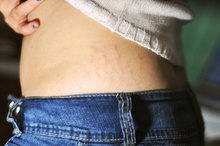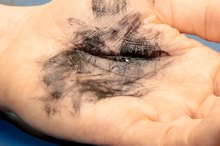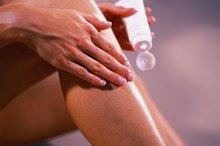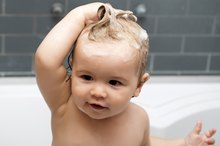What does fact checked mean?
At Healthfully, we strive to deliver objective content that is accurate and up-to-date. Our team periodically reviews articles in order to ensure content quality. The sources cited below consist of evidence from peer-reviewed journals, prominent medical organizations, academic associations, and government data.
The information contained on this site is for informational purposes only, and should not be used as a substitute for the advice of a professional health care provider. Please check with the appropriate physician regarding health questions and concerns. Although we strive to deliver accurate and up-to-date information, no guarantee to that effect is made.
Is Fabric Paint Safe for Babies?
A custom-made T-shirt or onesie for your baby is a fun and unique way to share your passions, interests and favorite subjects on your little one's clothing. That doesn't mean they are economical or easy to find, though. A bit of fabric paint can transform a baby outfit and make it something to show off. In most cases, fabric paint is safe for use on baby items, provided you take a few precautions.
Ingredients
With so many varieties of fabric paint available, it might be overwhelming when the time comes to make a choice. While each manufacturer has its own formula for mixing fabric paint, you're likely to encounter similar ingredients in each. Choose a fabric paint that claims to be nontoxic or one that contains no hazardous components. This information is usually displayed on the packaging, but a quick call to the manufacturer is a good way to get more details, if needed. Though your baby isn't likely to be eating the paint, a nontoxic version can set your mind at ease should she decide to nibble on her shirt or socks.
- With so many varieties of fabric paint available, it might be overwhelming when the time comes to make a choice.
- Though your baby isn't likely to be eating the paint, a nontoxic version can set your mind at ease should she decide to nibble on her shirt or socks.
Skin Safety
How to Cover Stretch Marks with Self Tanner
Learn More
Though the fabric paint on your baby's clothes is usually dry when he wears them, in some cases it could cause skin irritation. Since many types of baby T-shirts, socks and onesies are made with thin cotton material, fabric paint can sometimes cause it to pucker or harden on the backside of the painted image. When the material rubs against your baby's skin, it can be uncomfortable. For babies with sensitive skin, the problem could be exacerbated by wearing clothing made scratchy or stiff with fabric paint. To get around this, choose thicker fabrics to paint or layer the painted item over another piece of clothing to keep it from coming into contact with your little one's skin.
- Though the fabric paint on your baby's clothes is usually dry when he wears them, in some cases it could cause skin irritation.
Choking Hazards
Some types of fabric paints brush on, while others puff up during the drying process. The latter type can peel from the fabric, particularly after several trips through the washing machine and dryer. If your baby gets a hold of a chunk of peeling paint, she could remove it and put it into her mouth, posing the risk of choking. Examine clothing carefully before putting it on your little one, suggests the Consumer Reports website, which allows you to watch for peeling fabric paint. Fabric paint that brushes on is often a safer choice because it isn't as easy to remove from clothing, which helps keep your baby from putting it into her mouth.
- Some types of fabric paints brush on, while others puff up during the drying process.
- Examine clothing carefully before putting it on your little one, suggests the Consumer Reports website, which allows you to watch for peeling fabric paint.
Ingestion
How to Get Ink Off Hands
Learn More
Wet fabric paint may be more worrisome than when it's dry. Many parents create a keepsake baby item by dipping their little one's hands or feet into fabric paint and pressing it onto a T-shirt or onesie. In this case, it's important to make sure you thoroughly clean your little one's body parts carefully as soon as the project is complete. While most types of fabric paint aren't likely to cause problems, ingesting it might make your baby sick. If your baby happens to eat some fabric paint before you can get it wiped off, contact his pediatrician or your local poison control center for treatment, recommends the U.S. Department of Health and Human Services Household Products Database 1.
- Wet fabric paint may be more worrisome than when it's dry.
- While most types of fabric paint aren't likely to cause problems, ingesting it might make your baby sick.
Related Articles
References
Writer Bio
Eliza Martinez has written for print and online publications. She covers a variety of topics, including parenting, nutrition, mental health, gardening, food and crafts. Martinez holds a master's degree in psychology.









